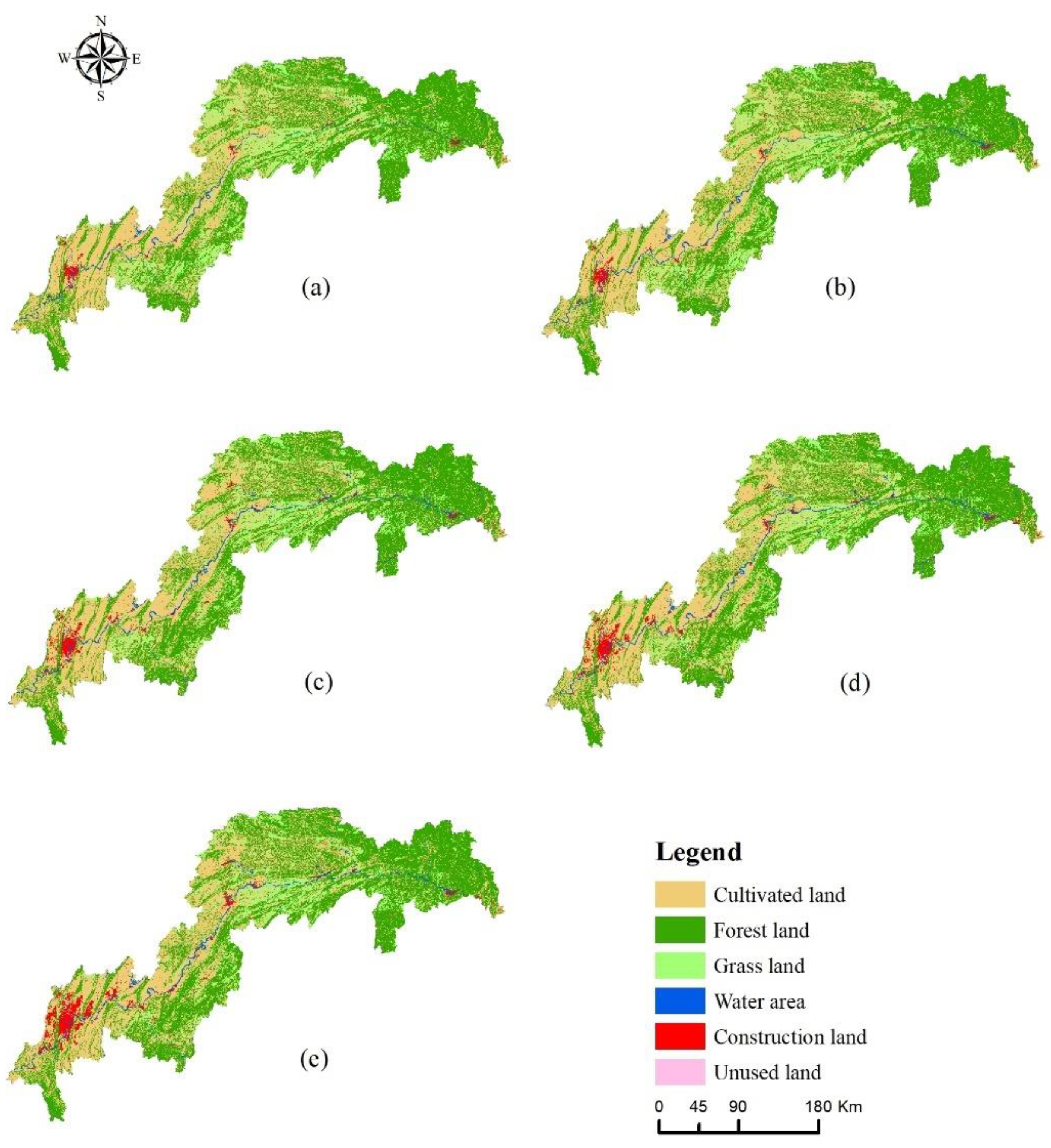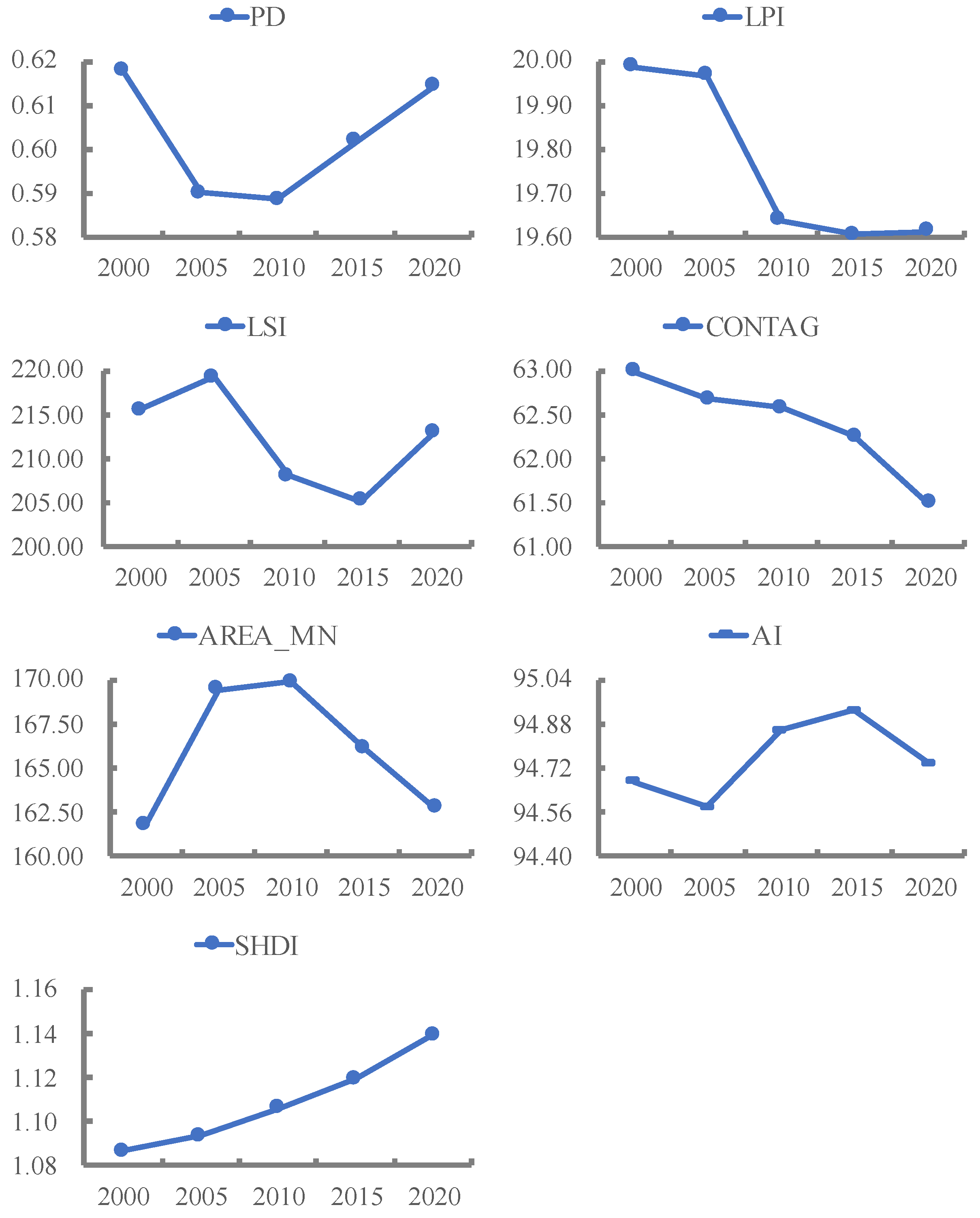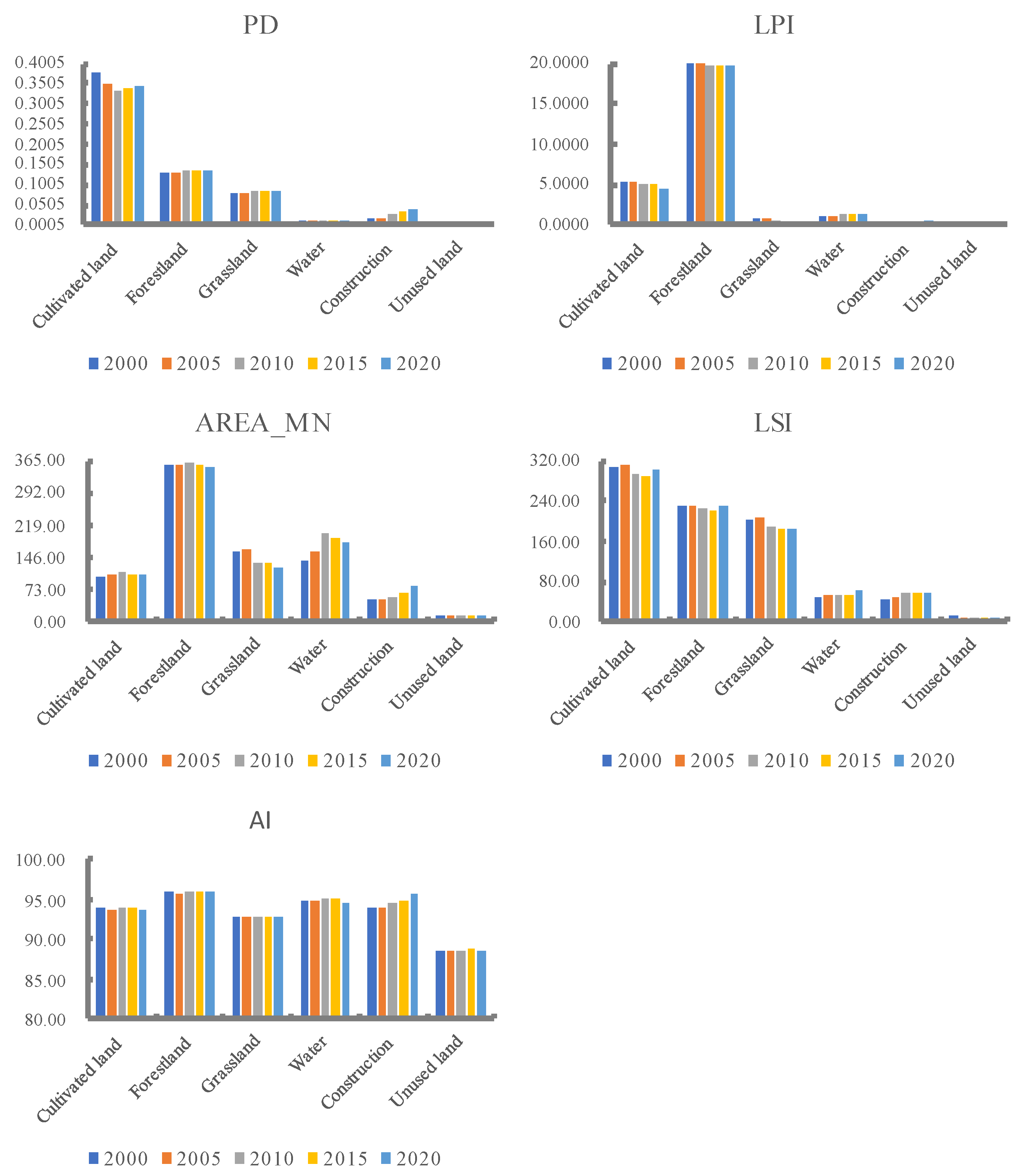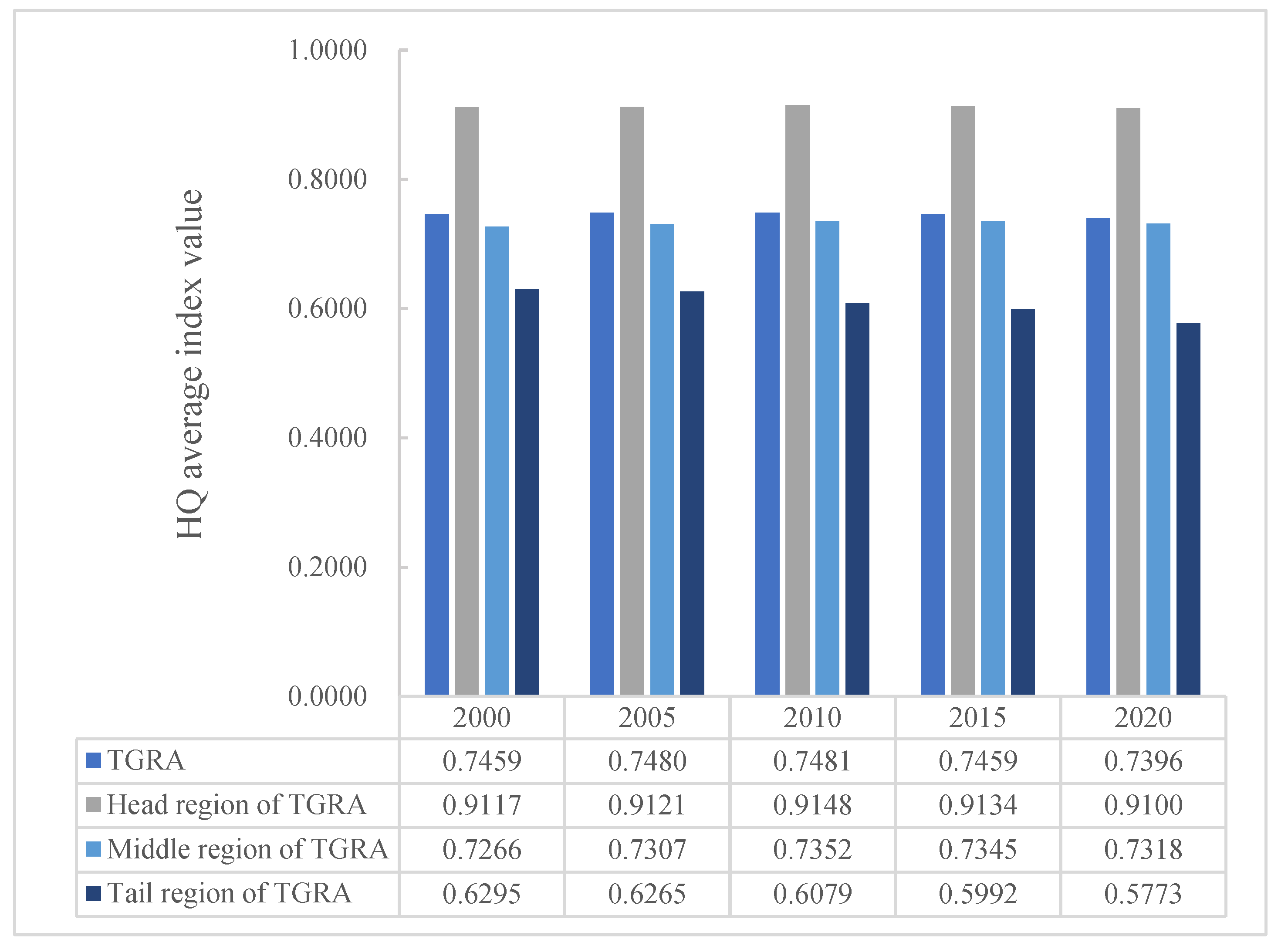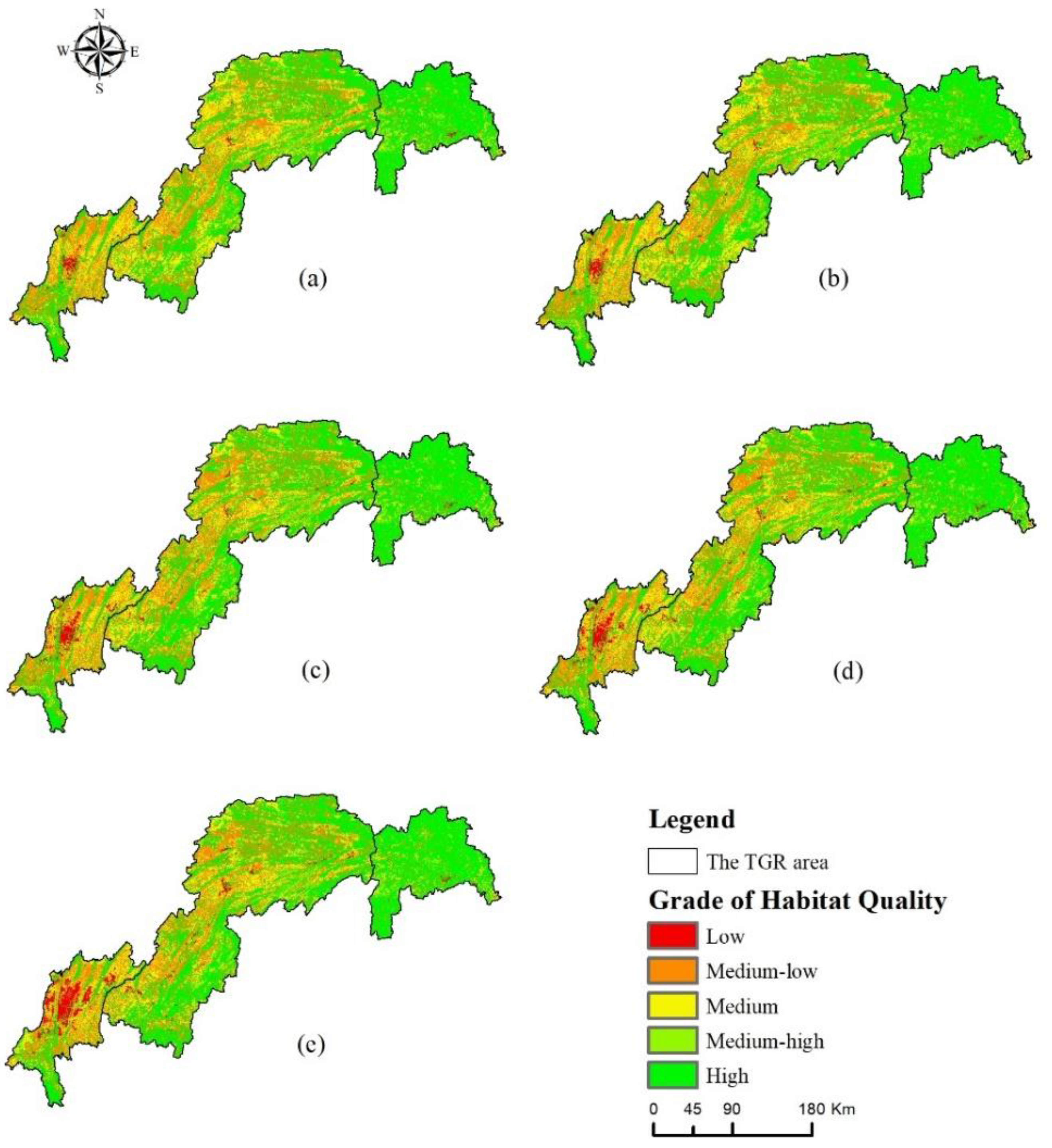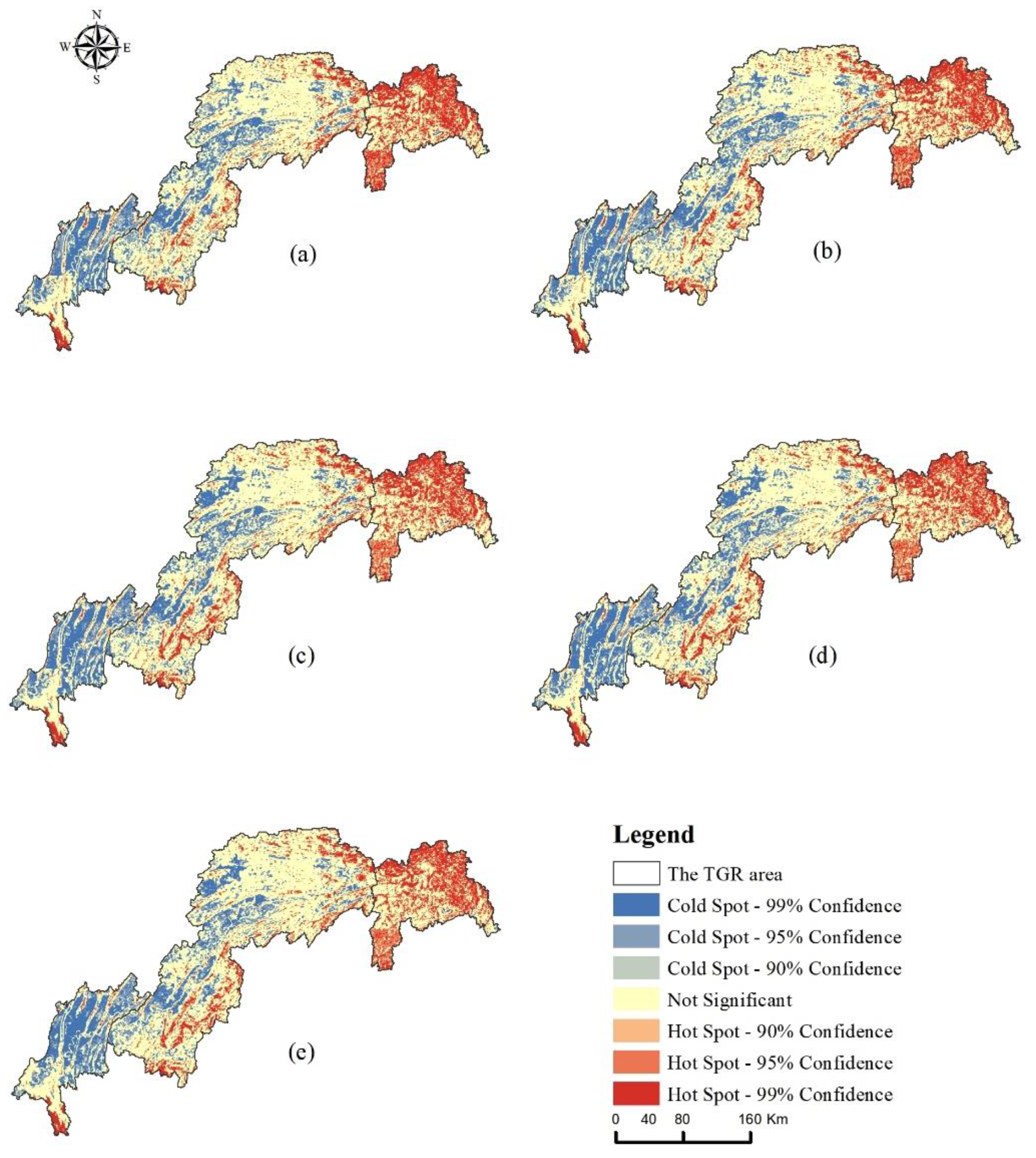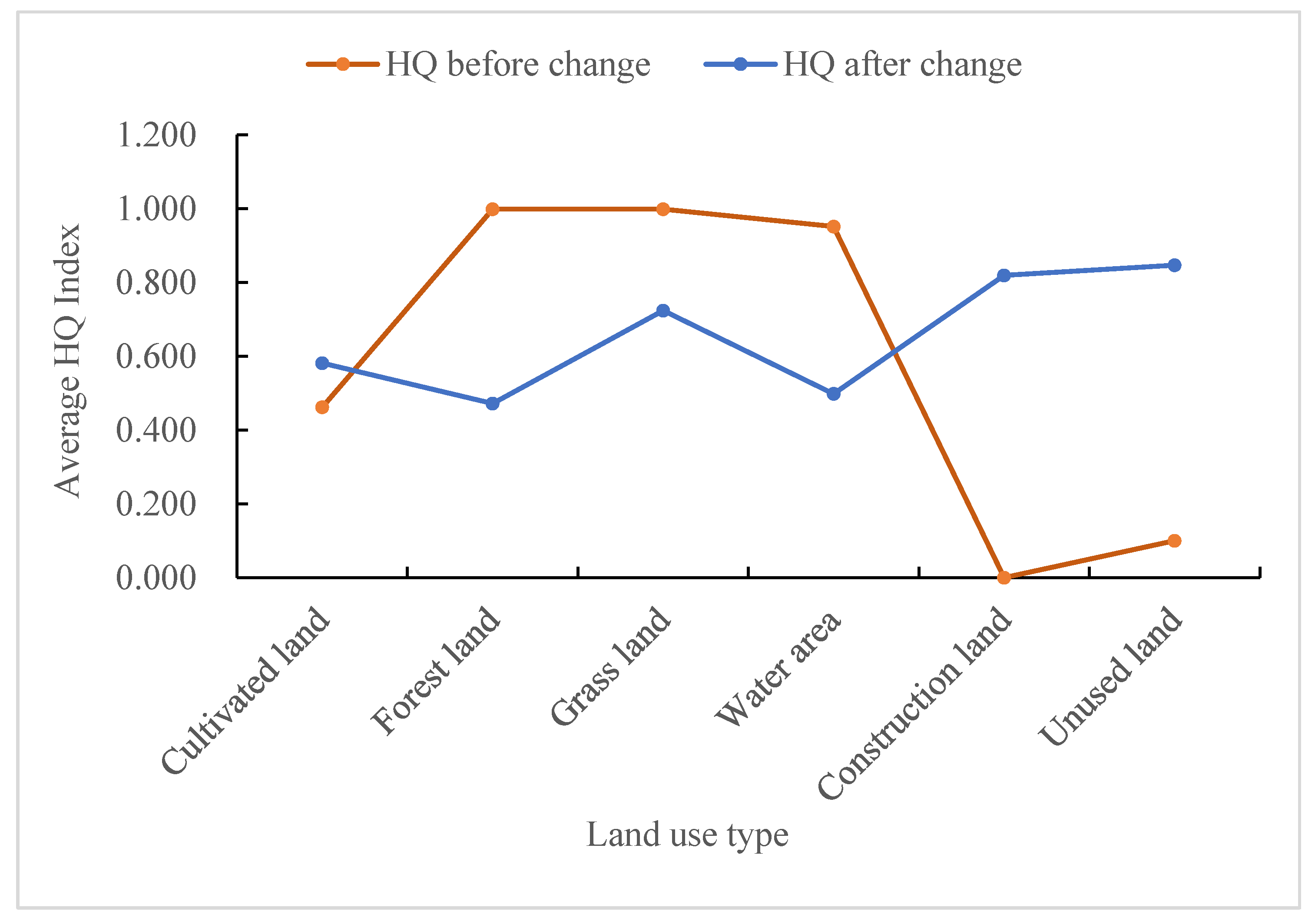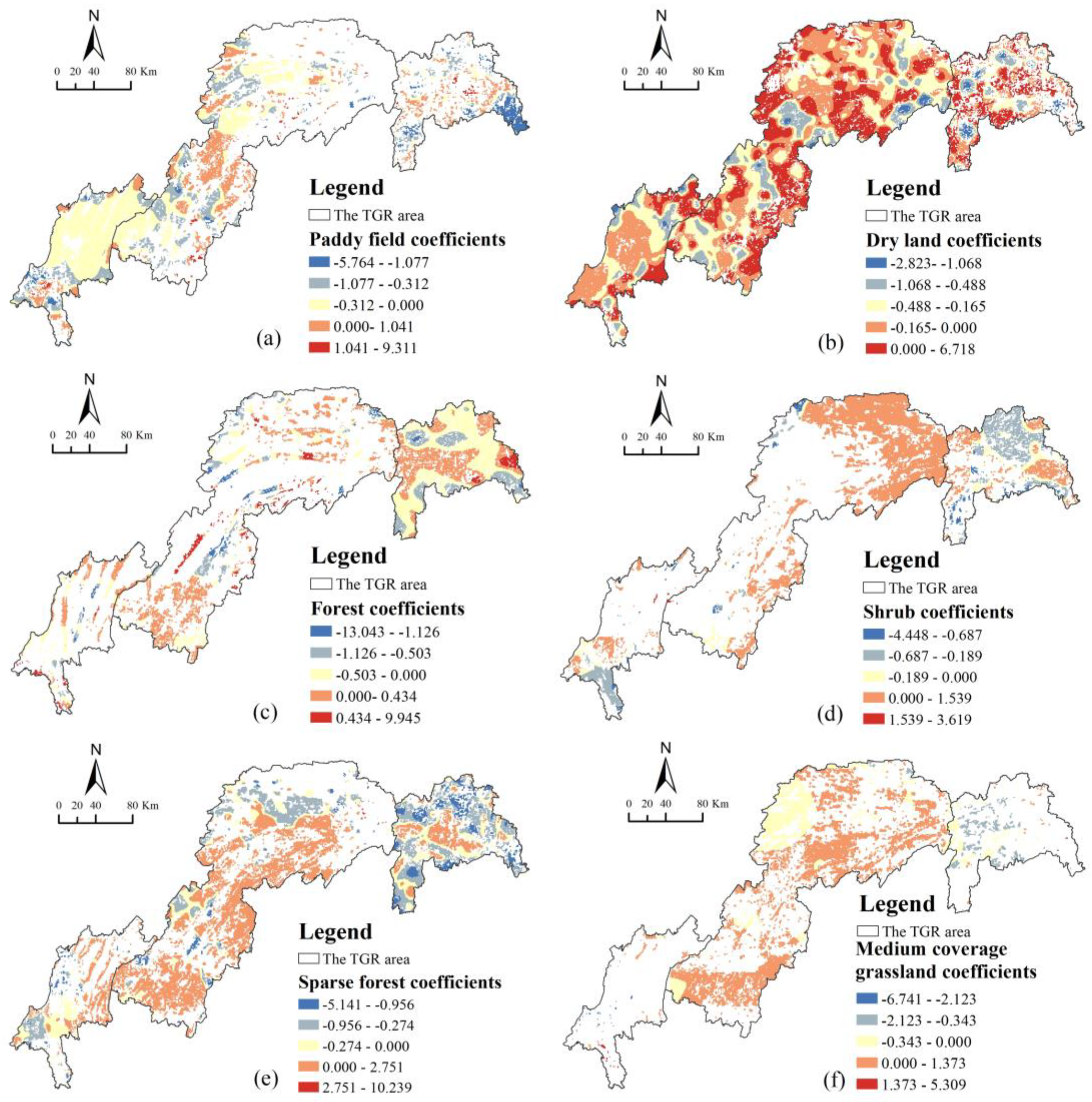1. Introduction
HQ refers to the ability of an ecosystem to provide a suitable living environment for individuals or populations [
1]. It is a key indicator of the quality of the ecological environment, reflecting the level of regional biodiversity and ecosystem services, which is crucial to ensuring the ecological security of the region [
2]. Land use change is an important factor causing changes in surface patterns and ecological environment. Blind expansion of land development and construction will lead to habitat degradation and fragmentation, thus affecting the material cycle and energy flow among habitat patches and bringing certain threats to the survival environment of species [
3,
4,
5]. In recent years, with rapid urbanization, human activities have accelerated the change in land use patterns, which has led to changes in HQ [
6]. Therefore, it is necessary to study the influence relationship between land use changes and HQ changes [
7,
8], which is important for achieving scientific land use planning and ecological environment protection.
In the early stages, HQ studies were mainly conducted on the species’ habitat quality in specific areas or the effects and impacts of different habitat conditions on a single species [
9,
10]. As research progressed, it became clear that the measurement and assessment of HQ required the integration of many characteristics of ecosystems [
11]. Currently, most studies on habitat quality use the indicator system evaluation method [
12] and the model method [
13], but the indicator system method has not yet formed a unified evaluation index and standard, whereas the model method is relatively more accurate and data are easier to obtain, as well as less time consuming, less costly and more visible [
14]. The habitat quality models mainly used at this stage are the Habitat Suitability Model (HSI) [
15], the Maximum Entropy Model (Mx Ent) [
16], and the InVEST model [
17,
18]. Among them, the InVEST model is mainly used for the assessment, management, and decision-making of ecosystem services, and the HQ module of this model is mostly used for habitat quality measurement in research [
19,
20]. The advantage of this model is that the sensitivity of habitats to threat sources is taken into account when assessing habitat suitability [
21], and it is not limited by study time, scale, and area. It is currently the most frequently applied model and is widely used for HQ assessment, spatial and temporal variability, and future prediction in cities [
22], watersheds [
23], nature reserves [
24], and coastal zones [
25]. In addition, in studies related to the effects of land use change on HQ, the models such as contribution index [
26], bivariate spatial autocorrelation [
27], ordinary least square (OLS) [
28], geodetector [
29], geographically weighted regression (GWR) [
30], multi-scale geographically weighted regression (MGWR) [
31] were mainly used to quantify and assess the relationship between land use change and habitat quality change. Among them, the multi-scale geographically weighted regression model (MGWR) can not only analyze the spatial response relationships at different scales [
32] but also better reveal the spatial response mode of land use change on habitat quality, providing an important means to explore the quantitative relationship between land use change and HQ in space.
The TGRA is located in the western part of China. It is a special ecological function area in the Yangtze River Basin and has an extremely important ecological status in China [
33]. Since the completion of the Three Gorges Project, urban construction and economic development in the TGRA have surged, and the land use pattern of the region has changed dramatically, resulting in regional habitat fragmentation, habitat degradation and reduced biodiversity [
34]. In recent years, with the implementation of a series of ecological projects, the ecological environment in some areas of the TGRA has improved significantly, but persistent human activity has made the human-land conflict still prominent, seriously threatening the HQ of the region [
35]. Therefore, it is necessary to study the evolution characteristics of HQ under land use change. At present, there are numerous studies on land use and habitat quality in the TGRA [
36,
37], but few studies have shown the spatial relationship between land use types and habitat quality. In addition, among the available studies on HQ in the TGRA, most of them select local areas for study and cannot clarify the HQ status of the whole area [
38,
39,
40]. At the same time, most of the studies have large differences in time points and lack evaluations for more recent periods [
38,
39]. Moreover, in the selection of parameters for HQ evaluation of the InVEST model, land use types are usually selected as habitat factors and threat factors, and the finer the classification of land use types and the smaller the scale of the raster data, the more accurate the evaluation results will be. However, most of the studies on HQ assessment in the TGRA focus on primary land use types [
40], and the accuracy of the assessment results needs to be improved.
Therefore, this study takes the TGRA in China as the research object, based on the land use data from 2000 to 2020 (5 years’ timestep), First, we quantitatively analyzed the land use change in the TGRA by using a land use transfer matrix, a land use rate model, and a landscape pattern index. Secondly, we used the HQ module of InVEST software to assess the spatial and temporal change state of HQ in the TGRA, and analyzed the spatial differentiation characteristics of HQ with the help of the spatial autocorrelation model. Based on this, we finally used the MGWR model to quantitatively analyze the spatial response relationship between HQ change and land use change. The objectives of this study are to improve the accuracy of the TGRA habitat quality assessment results based on secondary class land use data, to clarify the characteristics of land use and HQ changes in the study area from 2000 to 2020, and to understand how land use changes affect the HQ of the region. This aims to provide a scientific basis for land use planning and ecological environmental protection in the TGRA, and may also provide reference values for similar studies in other areas.
2. Material and Methods
2.1. Study Area
The TGRA is located in southwest China and belongs to the lower part of the upper Yangtze River basin. The geographical coordinates are 28°32′ to 31°50′ north latitude and 106°20′ to 110°30′ east longitude, with an area of about 57,368 km
2. The TGRA spans two provinces and cities, Chongqing and Hubei, and includes 26 districts and counties, 22 in Chongqing and 4 in Hubei (
Figure 1). The TGRA is dominated by mountains and hills and is characterized by complex landforms and undulating terrain. The topography is characterized by a spatial distribution of “low in the southwest and high in the northeast”. In recent years, the expansion of human activities and the frequency of natural disasters have resulted in soil erosion, wetland degradation, and reduced biodiversity in the TGRA [
33,
37], resulting in significant changes to the surface cover and threatening the quality of the ecological environment.
As the TGRA has unique geographical characteristics that span two provinces and municipalities, we utilize the zoning standards of the “General Plan for the Near-Term and Medium-Term Agricultural and Rural Economic Development of the TGRA” to better reflect the spatial distribution pattern of habitat quality in this area. We divided the TGRA into three sections: the head region, the middle region, and the tail region (
Figure 1).
2.2. Data Sources
In this study, five periods of land use data for 2000, 2005, 2010, 2015, and 2020 with a spatial resolution of 30m, were selected, all from the Data Center for Resources and Environmental Sciences, Chinese Academy of Sciences (RESDC) (
https://www.resdc.cn). The remote sensing interpretation of the land use data for 2000, 2005, and 2010 were based on Landsat-TM/ETM remote sensing image data, and the land use data for 2015 and 2020 were based on Landsat 8 remote sensing image data. The land use classification mainly refers to the CNLUCC data classification system, including 6 primary classes and 17 secondary classes, with the accuracy of primary classification reaching over 93% and the accuracy of secondary classification reaching over 90% to meet the research needs [
41].
This paper uses cultivated land, forest land, grassland, water area, construction land, and unused land as the mainland types for the study of land use change. Paddy land, dry land, forest land, shrub forest land, sparse forest land, other forest lands, high coverage grassland, medium coverage grassland, low coverage grassland, canal, lake, reservoir pond, tidal flat, urban land, rural residential area, other construction lands, and bare ground are used as the mainland types for calculating habitat quality. In addition, the natural breakpoint method was used for the threshold delineation of the relevant data values in this study.
2.3. Study Methods
The intensification of human activities is one of the important reasons for HQ degradation, and land use change can reflect the intensity of human activities. Currently, land use types are mostly used as model parameters to quantitatively evaluate HQ, but it is not deep enough to reveal the internal relationship between land use and HQ changes. Based on secondary land use data, this paper combines the InVEST model with the MGWR model to build a refined assessment framework, firstly, using the land use transfer matrix, land use rate model and landscape pattern index methods to quantitatively analyze the land use change, then using the HQ module of the InVEST model to assess the HQ of the study area, and then carry out spatial autocorrelation analysis and hotspot analysis on this basis. Finally, the MGWR model was used to analyze in detail the effects of land use change on HQ in the study area, and the spatial response of land use change on HQ evolution was discussed.
2.3.1. Analysis of Land Use Change Methods
- (1)
Land Use Transfer Matrix
To reflect the structural characteristics of land use changes in the study area over time and the transformation relationship between the types. Based on the ArcGIS platform, this paper constructs land use transfer matrices for 2000–2005, 2005–2010, 2010–2015, 2015–2020, and 2000–2020 to compare and analyze the spatial and temporal changes of each land use type in the TGRA, and the calculated expressions are shown in (1):
In the formula: is the land use status in the initial period and the end period, and n is the number of land use types.
- (2)
The Land Use Rate Model
The dynamic degree of land use can reflect the degree of change of a certain type of land use during the study period [
40], expressed by the following formula:
In the formula: is the change rate of land use type i and the value larger, the human activities stronger. and are the areas of land use type I at the beginning and the end of the research, and T is the study duration.
- (3)
Landscape Pattern Index Analysis
The landscape pattern index can reflect the spatial configuration and structural composition within the landscape and is an important index to describe the landscape pattern [
42]. In this study, the following landscape pattern indices were selected from the class level and landscape level to reflect the changing characteristics of land use in the TGRA. They include Patch Density (PD), Largest Patch Index (LPI), Landscape Shape Index (LSI), Mean Patch Area (AREA_MN), Contagion Index (CONTAG), Aggregation Index (AI) and Shannon’s Diversity Index (SHDI). The ecological significance and calculation of these landscape indicators are shown in Fragstats 4.2 software.
2.3.2. InVEST Model
This study used the InVEST model to calculate HQ in the TGRA from 2000 to 2020. The principle of this calculation is to assume that habitat quality values are continuous variables belonging in the range from 0 to 1. The closer the value is to 1, the better the habitat quality, indicating better adaptation to species survival and better biodiversity. The closer the value is to 0, the worse the habitat quality, indicating that the ecosystem is less able to support the survival and reproduction of species, which is detrimental to the maintenance of biodiversity in the region [
43]. In this paper, HQ is calculated based on the sensitivity of different land use types and the intensity, location, and maximum impact distance of different threat sources using land use data and drawing on relevant studies [
23,
37]. The calculation equation is as follows:
In the formula:
represents the habitat quality value corresponding to grid pixel
in land use type
;
represents the habitat adaptability value corresponding to land use type
;
is a constant, and its value is usually 2.5;
represents the weighted average of various threat sources corresponding to grid pixel
in land use type
;
represents half-saturated constant, usually the default value is 0.5, the threat source. The parameters and sensitivity are shown in
Table 1 and
Table 2.
2.3.3. Spatial Auto-Correlation and Hot Spot Analysis
Spatial auto-correlation is a quantitative description of the similarity of attribute values or spatial association patterns of adjacent units in space, and it is used to determine the degree of spatial association of an attribute between neighbouring units. There are two types of spatial autocorrelation: global spatial auto-correlation and local spatial auto-correlation. The global spatial auto-correlation Moran’s I was used in this study to describe the spatial correlation of habitat quality in the study area. Moran’s I values ranged from [−1, 1], with values greater than 0 indicating positive correlation and less than 0 indicating negative correlation, and its absolute value indicating the strength of correlation. The hotspot analysis method was used in this study to investigate the local spatial clustering characteristics of HQ and to determine whether there was high-value or low-value aggregation. The specific formulae for the two spatial analysis methods are mainly referred to in the literature [
44].
2.3.4. Multiscale Geographically Weighted Regression (MGWR) Model
Multiscale geographically weighted regression (MGWR) models allow for different levels of spatial smoothing for each variable and use different bandwidths for each independent variable to determine the spatial scale at which each dependent variable acts [
32]. According to related research, the MGWR model is more consistent with geographic process spatial heterogeneity than the geographically weighted regression (GWR) and multiple linear regression (OSL) models [
28]. The amount of change in habitat quality was chosen as the dependent variable for this study, and the amount of change in land use type area was chosen as the independent variable.
In the formula: is the dependent variable; is the independent variable, representing the local parameter estimation of the th independent variable of sample ; is the bandwidth used by the regression coefficient of the th variable, the relationship between the independent variable and the dependent variable allows change space; are the coordinates of the geographical location of sample ; is the regression coefficient of the independent variable; is the random error.
5. Conclusions
This study takes the TGRA in China as the study area and uses the InVEST model to measure the HQ level in the study area for the past 20 years by selecting five phases of land use data, combining the land use transfer matrix, land use rate model, and landscape pattern to analyze the spatial and temporal evolution characteristics of habitat quality from a directional and quantitative perspective, and exploring the response state of HQ changes to each land use change spatially based on the MGWR model. The results show that from 2000 to 2020, the land use in the TGRA shows a changing state of “urban expansion, cultivated land shrinkage, forest land growth, and grassland degradation”; The direction of land use transfer is mainly manifested in the transfer of cultivated land and grassland to forest land and construction land, which made the patch fragmentation of cultivated land and grassland deepen, whereas the patch aggregation degree of forest land and construction land increased and the connectivity became better; In the past 20 years, the HQ in the study area has shown a trend of “rising first and then declining”. The high values of HQI are mainly concentrated in the mountainous areas in the northeast of the TGRA, and low values mainly in the urban areas in the western part of the TGRA and along the Yangtze River. The impact of each land use type on habitat quality has significant spatial and temporal heterogeneity, with changes in the area of paddy fields and drylands negatively correlated with changes in HQ, and changes in the area of shrub lands, sparse forest lands and medium-cover grasslands significantly positively correlated with changes in HQ.

